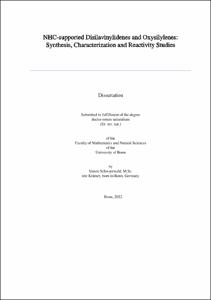NHC-supported Disilavinylidenes and Oxysilylenes: Synthesis, Characterization and Reactivity Studies

NHC-supported Disilavinylidenes and Oxysilylenes: Synthesis, Characterization and Reactivity Studies

| dc.contributor.advisor | Filippou, Alexander C. | |
| dc.contributor.author | Schwarzwald, Simon | |
| dc.date.accessioned | 2023-07-06T12:21:24Z | |
| dc.date.available | 2023-07-06T12:21:24Z | |
| dc.date.issued | 06.07.2023 | |
| dc.identifier.uri | https://hdl.handle.net/20.500.11811/10928 | |
| dc.description.abstract | Vinylidenes (:C=CR2) are a transient subclass of carbenes and readily isomerize to the respective alkynes (R C≡C R). While stabilization by metal coordination is possible, their instability is commonly utilized in the Corey Fuchs-reaction or the Seyferth–Gilbert homologation. By contrast, several examples of (base stabilized) heavier vinylidene analogues have been introduced to the scientific community within the last decade. The first chapter of this work is centered around the exploration of the synthetic potential of the first NHC stabilized disilavinylidene, (SIDipp)Si=Si(Br)Tbb (1), that was isolated by Dr. P. Ghana from the Filippou group in 2015. Alkylation reactions of 1 with benzylalkali compounds are dependent on the alkali metal and led either to the anticipated substitution products (M = Li) or their cyclic isomer, an NHC-stabilized disilacyclopropylidene (3, M = K). The reactions were calculated to traverse via rare metallasilylenes, which is supported by the isolation of unprecedented NHC-stabilized zinco-silylenes (5 and 6) after 1,2-additions of ZnX2. Those, in turn, were found to lie in equilibrium with ZnX2 pi complexes at the Si=Si double bond and careful coordination of Cu(I) and Ag(I) salts led to stable coinage metal complexes (9 – 11). Surprisingly, the reaction with CuOtBu induced an isomerization of the vinylidene moiety and gave an extremely rare side-on complex of an NHC-stabilized disilyne (12). After treatment with small Lewis bases, the metastable NHC stabilized (oxy)disilavinylidene 14 was isolated and its thermal rearrangement to the isolable NHC stabilized (oxy)disilavinylidene 15 was followed both experimentally as well as by theory. This is the first time isomerization reactions of a disilavinylidene or disilyne moiety have been reported. Although “Fischer carbenes”, transition metal complexes of (oxy)carbenes, are the oldest known carbene complexes and found applications in C C coupling reactions, free oxy carbenes remain a very rare academic curiosity. Contrary, heavier di(oxy)tetrels E(OR)2 (E = Ge, Sn, Pb) are readily available since the 1980s and found only limited application. Whereas the race to the first silanone O=SiR2 has been won by Filippou in 2014,[120] their low valent derivatives Si(OR)2 are nearly unheard of and only two examples were published parallel to the course of this work in 2018 and 2019 by the groups of Inoue and Aldridge. Systematic substitution reactions of Si(II) precursors with alcoholates led to the isolation of NHC stabilized oxy(halo)silylenes SiX(OtBu)(NHC) (16, X = Br, I), an hyperconjugated {C5Me5}Si(OArMes) (17) and finally the first di(aryloxy)silylene Si(OArMes)2 (19) as well as an isostructural di(amino)silylene Si{N(Me)ArMes}2 (18). At that time, compound 19 was the only example of a two coordinate Si compound with a Si O bond and was extensively studied. Akin to the heavier E(OR)2, thermolysis of 19 lead to crude Si nanoparticles whereas reactions with polar substrates such as alcohols, silanes, boranes, phosphanes or ZnMe2 gave access to a wide variety of oxidation products. For steric reasons, the Lewis acidic silylene only reacts with very small carbenes but a reaction with 2 equiv. of N2C(H)Si(iPr3)3 readily gave Si{HN=NC(H)Tips}{N≡NCTips}(OArMes)2 (22) as a result of an ambiphilic reaction. | en |
| dc.language.iso | eng | |
| dc.rights | In Copyright | |
| dc.rights.uri | http://rightsstatements.org/vocab/InC/1.0/ | |
| dc.subject | Silizium | |
| dc.subject | niedervalent | |
| dc.subject | Molekularchemie | |
| dc.subject | Silylen | |
| dc.subject | Vinyliden | |
| dc.subject | Disilavinyliden | |
| dc.subject | Carben | |
| dc.subject | Oxysilylen | |
| dc.subject | Disilin | |
| dc.subject | silicon | |
| dc.subject | low valent | |
| dc.subject | silylene | |
| dc.subject | vinylidene | |
| dc.subject | disilavinylidene | |
| dc.subject | oxsilylene | |
| dc.subject | carbene | |
| dc.subject | disilyne | |
| dc.subject | molecular chemistry | |
| dc.subject.ddc | 540 Chemie | |
| dc.title | NHC-supported Disilavinylidenes and Oxysilylenes: Synthesis, Characterization and Reactivity Studies | |
| dc.type | Dissertation oder Habilitation | |
| dc.publisher.name | Universitäts- und Landesbibliothek Bonn | |
| dc.publisher.location | Bonn | |
| dc.rights.accessRights | openAccess | |
| dc.identifier.urn | https://nbn-resolving.org/urn:nbn:de:hbz:5-71119 | |
| ulbbn.pubtype | Erstveröffentlichung | |
| ulbbn.birthname | Krämer | |
| ulbbnediss.affiliation.name | Rheinische Friedrich-Wilhelms-Universität Bonn | |
| ulbbnediss.affiliation.location | Bonn | |
| ulbbnediss.thesis.level | Dissertation | |
| ulbbnediss.dissID | 7111 | |
| ulbbnediss.date.accepted | 04.04.2023 | |
| ulbbnediss.institute | Mathematisch-Naturwissenschaftliche Fakultät : Fachgruppe Chemie / Institut für Anorganische Chemie | |
| ulbbnediss.fakultaet | Mathematisch-Naturwissenschaftliche Fakultät | |
| dc.contributor.coReferee | Streubel, Rainer | |
| ulbbnediss.contributor.orcid | https://orcid.org/0000-0002-6783-2931 |
Files in this item
This item appears in the following Collection(s)
-
E-Dissertationen (4119)




